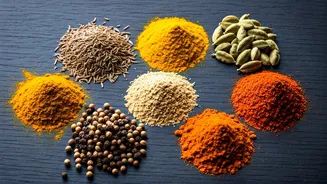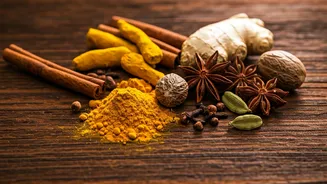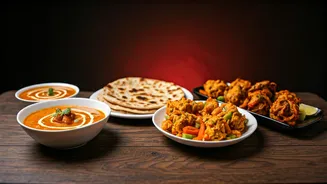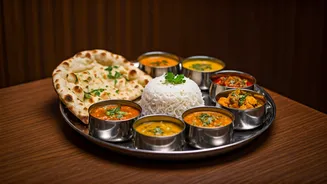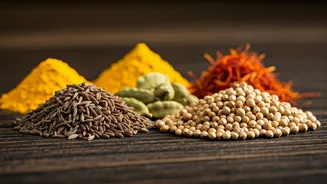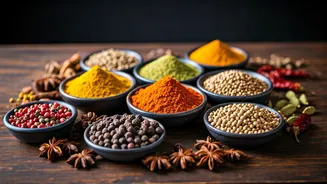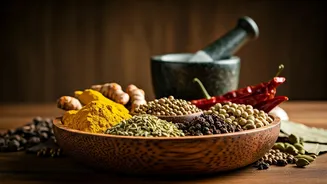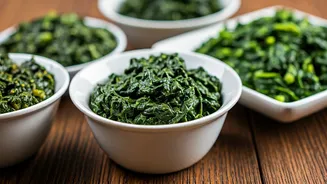Spice Rack Essentials
The cornerstone of Indian cooking lies in its extensive spice collection, a vibrant array that adds depth, complexity, and distinct regional nuances. Several
spices are considered indispensable, and a well-stocked pantry is the first step toward mastering Indian cuisine. Turmeric, often called the 'golden spice,' is a cornerstone, recognized for its vibrant color, earthy flavor, and anti-inflammatory properties. Then there's cumin, with its warm, earthy notes, is a regular ingredient in curries and lentil dishes. Coriander seeds, offering a citrusy and slightly sweet taste when ground, are important for both flavor and texture. Chili powder or cayenne pepper, providing the necessary heat, is used according to personal preference, allowing one to control the spiciness of dishes. Garam masala, a complex blend of roasted spices, enhances the overall flavor profile. Lastly, cardamom, with its strong, aromatic and slightly sweet profile, is often added to desserts and beverages. Starting with these staples lays the foundation for creating a wide variety of authentic Indian dishes.
Curries: The Heart
Curries, the soul of Indian cuisine, demonstrate the diversity in flavors and regional distinctions. The base of most curries starts with a blend of onions, tomatoes, ginger, garlic, and spices, which are then sautéed to release their flavors. The blend and ratio of spices determines the dish's flavor, with regional variations adding a personal touch. Northern Indian curries often feature rich, creamy sauces with cashew-based gravies and cream, while southern Indian curries, known for their sharp, spicy profiles, often use coconut milk and tamarind. Butter chicken, a favorite worldwide, has a rich, creamy tomato-based sauce. Palak paneer, a vegetarian favorite, combines spinach with fresh paneer cheese. Chicken tikka masala, originally believed to be created in the United Kingdom, is another favorite and includes chicken chunks marinated in yogurt and spices. The wide range of curries, from mild to fiery, enables everyone to enjoy Indian cuisine.
Lentils and Rice Dishes
Lentils (dal) and rice are staples in Indian meals, providing balance and nourishment to the diet. The preparation of lentil dishes varies across the nation, with each region showcasing its unique recipes. Tarka dal is a straightforward dish, made by tempering the cooked lentils with cumin seeds, garlic, and chilies. Dal makhani, a more luxurious dish, is made with black lentils and kidney beans, slow-cooked for hours in a creamy tomato sauce. Rice is another essential aspect, used to absorb the flavours of the curries. Basmati rice, recognized for its fragrance and extended grains, is a common choice. Rice is also cooked in various forms like pulao, which combines rice with vegetables and spices, or biryani, which is layered with meat or vegetables, along with saffron and aromatic spices. The combination of rice and lentils provides a complete source of plant-based protein, serving as a pillar of Indian cuisine.
Regional Specialties
Indian cuisine is characterized by its wide variety, with regional variations showcasing unique ingredients and cooking styles. Each state has its specialized dishes, reflecting its environment and cultural traditions. In the North, tandoori dishes, cooked in clay ovens, are especially popular. In West Bengal, the cuisine prioritizes fish and rice, enhanced by the subtle use of spices. The South, known for its use of coconut milk, tamarind, and curry leaves, offers a range of flavorful dishes like dosas and idlis. Goan cuisine combines Indian and Portuguese influences, resulting in dishes like vindaloo, a spicy pork stew, that are both bold and full of flavour. These regional distinctions highlight the dynamic characteristics of Indian cuisine, making each culinary encounter a new experience, filled with variety.
Cooking Techniques and Tips
Mastering cooking methods is critical to achieving authentic Indian flavors. Sautéing spices in hot oil (tempering) is a common method that draws out the flavours, producing aromatic and delicious dishes. The art of layering spices at different stages of cooking intensifies the flavors. Grinding fresh spices is recommended, as it enhances the fragrance and flavour of the dish. Slow cooking is important for many dishes, enabling the ingredients to combine and the tastes to develop. Using a mortar and pestle for grinding spices helps to extract their rich aromas. Experimentation is highly advised, as Indian cooking is all about exploring new flavors and customizing dishes according to one's taste. The key to great Indian food is patience, using the best ingredients, and experimenting to learn different tastes.
